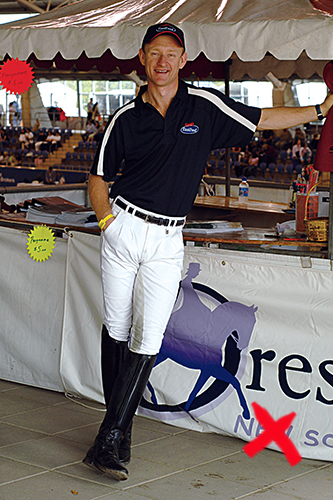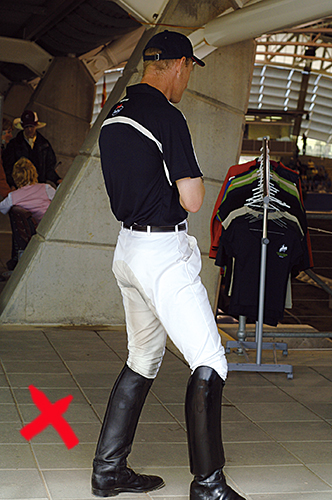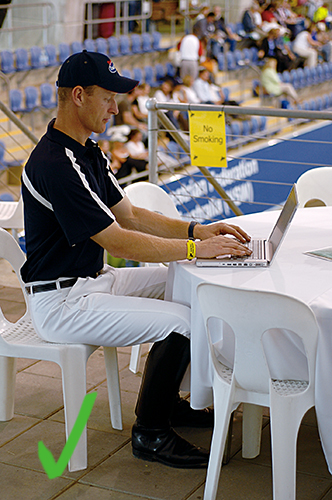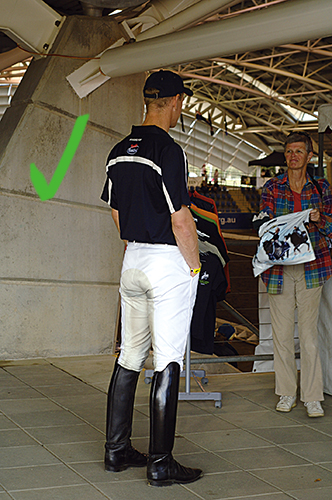By Lisa Champion MSc (exercise science)
Many thanks to supermodel Brett Parbery!
Let’s make the assumption that riders, when performing flat work, want to sit up straight on their horses, be balanced, use both sides of their bodies with equal effectiveness, and look poised and elegant (yes, even you blokes!) when they ride. But can most of us achieve this? For some reason, these goals are very difficult to accomplish and we often end up blaming our trusty mount. It’s the horse who’s stiff on one side, doesn’t like to bend to the right or left, only does lateral work well in one direction, or won’t pick up a canter lead as well on one side as the other. I’d like to suggest that it isn’t always the poor horse’s fault!
Why can’t the majority of us sit up straighter, be softer, more elegant, use our bodies more evenly and influence our horses more effectively? One answer to this question is our postural habits. Put in one simple sentence: you can’t expect to look and feel great on a horse if you sit and stand around all day, every day with poor posture. There are three main postural habits that get us into trouble. The first is slumping.
Rounding your shoulders, letting your tummy bulge out a bit, dropping your head slightly forward and losing your backside (the classic flat bottom look) are all signs of a slumper. Slumping, when sitting or standing, is the most common poor postural habit.
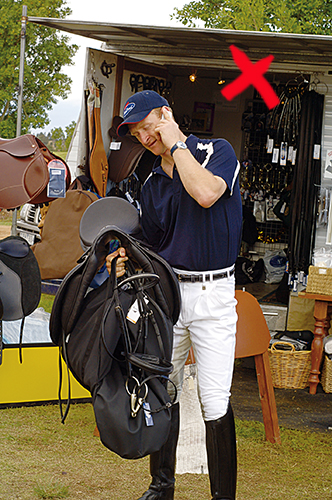 The second is the swayback. If you tend to sit and stand with your lower back a bit arched and your feet turned out a bit, you are most likely a swayback. Swaybacks are often ex-dancers, gymnasts, athletes and people who have been very flexible as children.
The second is the swayback. If you tend to sit and stand with your lower back a bit arched and your feet turned out a bit, you are most likely a swayback. Swaybacks are often ex-dancers, gymnasts, athletes and people who have been very flexible as children.
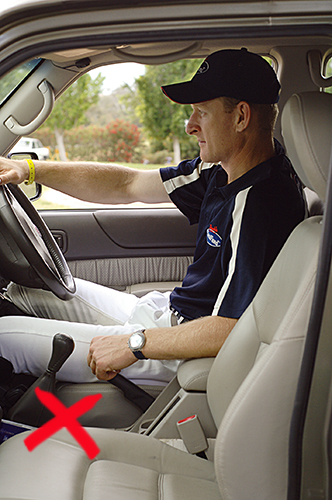 The third incorrect habit is sideways curving. Most of us will either slump or sway, and then have a bit of a sideways curve to boot. Be aware of your sideways curving habits for a day or so and you’ll probably notice that you tend to always lean to the same side, stand with the same leg slightly bent, and carry things more on one side of the body than the other. Another time to check your posture is when you’re driving. Do you always tend to lean on the console? Becoming aware of your postural habits is the first step towards improving them!
The third incorrect habit is sideways curving. Most of us will either slump or sway, and then have a bit of a sideways curve to boot. Be aware of your sideways curving habits for a day or so and you’ll probably notice that you tend to always lean to the same side, stand with the same leg slightly bent, and carry things more on one side of the body than the other. Another time to check your posture is when you’re driving. Do you always tend to lean on the console? Becoming aware of your postural habits is the first step towards improving them!
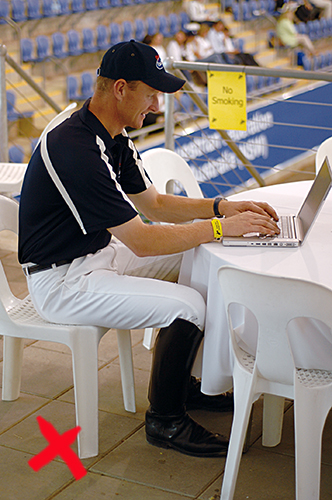 The bottom line is if you are slumping, swaying and sideways curving for all your waking hours, it will be very difficult to ‘sit up straight and evenly’ for the one hour that you ride your horse. If you ride many horses in one day, it will be even more difficult because the more tired you become, the more you will revert to your poor posture position. The reason you can’t just ‘sit up straight’ is simple. Poor posture leads to muscle imbalances in our bodies. If you’re a slumper, the muscles in the front of your chest shorten and tighten pulling your shoulders into the rounded position. The opposite muscles in your back become weak from being long and stretched out all the time and can’t do their job to hold you more upright. When you sideways curve, the muscle on one side of the body become shorter and tighter than the muscles on the other side. Add to the equation the dynamic movement of riding and the plot is lost even further. As you realize that you are slumping or leaning off to the side in the saddle you’ll grip and tighten with all the other muscles in the body to try and sit up straighter. This gripping and tightening leads to your horse not going as well and a pattern is set that is difficult to break.
The bottom line is if you are slumping, swaying and sideways curving for all your waking hours, it will be very difficult to ‘sit up straight and evenly’ for the one hour that you ride your horse. If you ride many horses in one day, it will be even more difficult because the more tired you become, the more you will revert to your poor posture position. The reason you can’t just ‘sit up straight’ is simple. Poor posture leads to muscle imbalances in our bodies. If you’re a slumper, the muscles in the front of your chest shorten and tighten pulling your shoulders into the rounded position. The opposite muscles in your back become weak from being long and stretched out all the time and can’t do their job to hold you more upright. When you sideways curve, the muscle on one side of the body become shorter and tighter than the muscles on the other side. Add to the equation the dynamic movement of riding and the plot is lost even further. As you realize that you are slumping or leaning off to the side in the saddle you’ll grip and tighten with all the other muscles in the body to try and sit up straighter. This gripping and tightening leads to your horse not going as well and a pattern is set that is difficult to break.
So, what can you do? The answer is simple. Increase your postural awareness. All day, every day, take note of how you are sitting and standing. If you are a riding instructor, try not to stand curved to one side with your head tilted as you watch your students ride. Make a pact with a buddy or your kids or partner to tell you every time they catch you slumping or curving off to the side. Sit evenly, balanced on your sitting bones, when you are in front of the computer or in a meeting. Stand evenly on two feet and try not to lean on things. Sit evenly when you are driving your car. Think a bit taller and more upright, but try not to pull your shoulders back and down. This will cause unwanted tension in your upper back. Just gently ‘lift your centre dot’ (in Riding from the Inside Out speak) and grow a little from the crown of your head. Take pride in your posture when you are off the horse and you may be surprised how much it influences how you ride.
Finally, as a first step to better riding, you can’t do anything better than increasing your postural awareness. But to even your body out after years of poor postural habits, you will also need to do some good stretches and strengthening exercises. I’ll keep encouraging you with some ideas of what to do in future issues of The Horse Magazine.
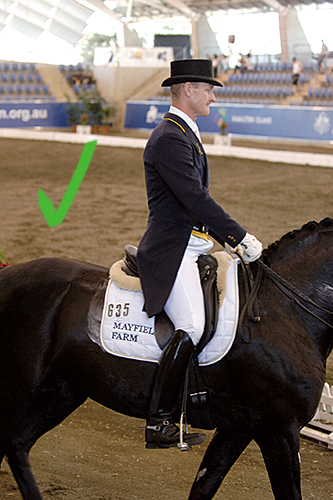 This article was first published in THM December 2005.
This article was first published in THM December 2005.



